I’m so glad you’re reading this guide for step-by-step instructions to take your small business online. It means you’re serious about turning your business idea into a reality or taking your enterprise to the next level. You understand that to truly compete in today’s marketplace, you need a strong presence on the internet. That’s where your customers like to spend a whole lot of their time — reading, watching, researching, socializing and buying.
Fact: Nearly 90 percent of Americans use the internet — and they turn to the web more than any other source to find local businesses and services. If you’re not online, you don’t exist to countless potential customers.
You’re missing a HUGE opportunity to:
Be more accessible
Don’t penalize me for shoe shopping at midnight — enable me! Unlike an actual storefront, a website doesn’t close up shop at 5 p.m. It’s open 24/7 to showcase your products and services, contact information, store hours, and more.
Build your brand
No big advertising budget? No problem. No matter how small you are, you can afford to use a website, social media profiles and other web-based efforts to raise brand awareness, establish
credibility, and develop a loyal — and growing — customer base.
Establish credibility
I can’t find your business ANYWHERE online? No website or Facebook business page or Yelp review? You must not be legit. Sorry, that’s how consumers think these days.
Connect with customers
We all want to be Liked, right? The internet offers endless possibilities for engaging with your target audience, in real-time, in the comfort of your pyjamas.
Generate sales leads
Because let’s be real — that’s what it’s all about. You can boost your customer base with a website, social media profiles, contact forms, and email marketing campaigns. I promise.
 Your digital footprint
Your digital footprint
Sure, it’s fine to start with a Facebook business page or an Etsy store as you test the waters of taking your small business online. But as you get serious about competing online (and off), you’ll want to expand your digital footprint to include a number of important elements.
Custom domain name
Your domain name, is the heart of your business’s unique address on the web. It should tell people who you are and what you have to offer at a glance, direct them to your website, and help protect and promote your brand.
Website
Your website is your business’s online home. It’s where you tell your story, showcase products and services, and start to establish credibility and expand your reach.
Social media
Getting active on the social networking sites where your customers spend their time is key to building an online community around your business. You can use sites like Facebook, Twitter, Pinterest, Instagram, LinkedIn and YouTube to market your products and services, establish yourself as a thought leader in your industry and, most important, build relationships with your customers.
Branded email is an affordable and effective way to communicate with your customers and generate leads.
Local reviews and directories
You can inspire consumer confidence (ahem, get more new customers) by garnering positive reviews on third-party sites like Yelp and remaining current on business directories such as Google My Business.
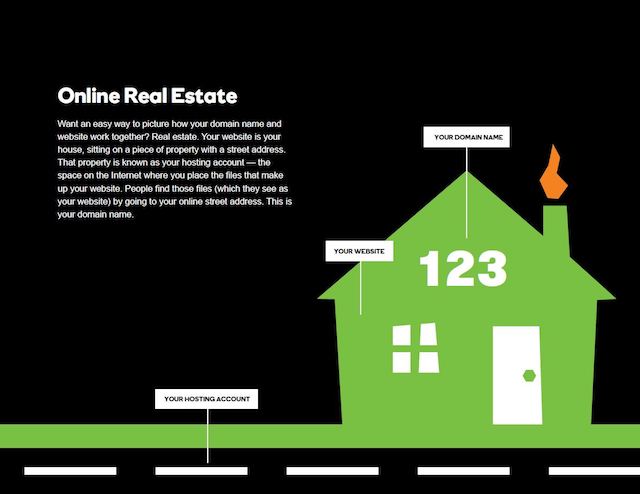
Play to win
Taking your small business online means putting your business in the game. And playing to win means taking a strategic approach to building a web presence, including:
-
Getting a domain name that represents who you are and what you do.
-
Taking a strategic approach to planning your website.
-
Launching a website dedicated to telling your story.
-
Creating valuable content.
-
Making sure the right people see that content.
-
Connecting with target customers on social media.
-
Driving traffic to your website.
-
Using your website, email and directories to generate leads.
-
Measuring, then tweaking for improvement.
This guide will show you how to take your small business online, step by step. Ready? Onward!
1. Get a domain
Your domain is the part of your website address that comes after the www. Like this:
www.coolexample.com
For a business, a domain name can also anchor a professional email address. Like this:
ceo@coolexample.com
Let’s say I’m looking for a plumber in Detroit. I whip out my iPhone, tap Google, and enter “plumber in detroit mi” — and voilà! I get a list of search results that include relevant websites
identified by their domain names.
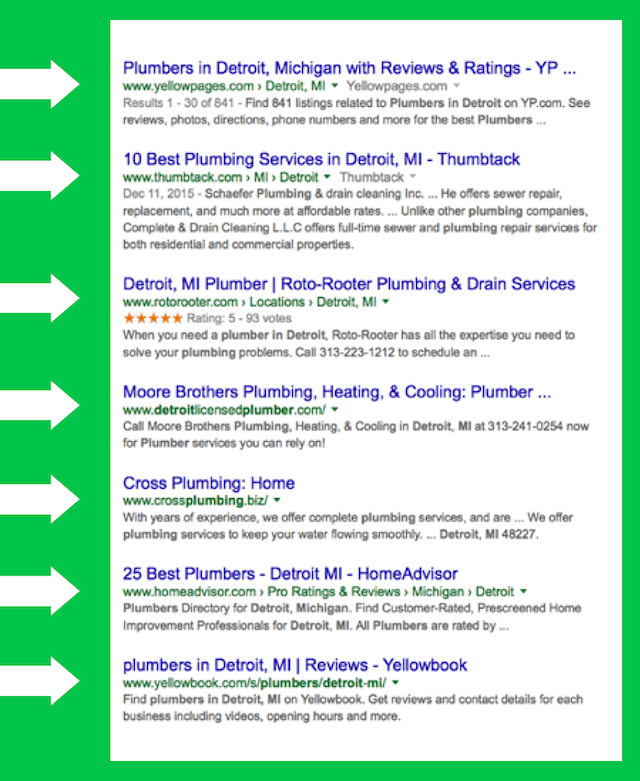
You want your business to show up in search results when potential customers are looking online for the products or services you offer. That’s the goal. Getting a domain name is the
first step to reaching it.
What’s a domain extension?
A top-level domain (TLD) is the domain’s extension — the part of the domain name following the “dot,” like the bold part in these examples:
coolexample.com
coolexample.net
coolexample.guru
coolexample.nyc
Coolexample.photography
The most common domain extensions are .com, .net, .info, .co and .org. You’ve probably seen a bunch of websites with domain names ending in these extensions because they’ve been around for long time (at least in internet years). That’s why it can be tough to secure a short and memorable domain name with those extensions.
Well, you’re in luck. We’re in the midst of a domain name revolution. Hundreds of new domain extensions known as generic top-level domain names (gTLDs) are becoming available — giving you the chance to snag a domain name that’s highly relevant to your industry (like .photography, .restaurant, .design, .consulting, .plumbing and .healthcare) and location (such as .nyc, .vegas and .london).
Go fish (for gTLDs)

Say your name is Tom and you own a tropical fish shop in the Bronx. Try different combinations of your business name, industry, primary product or service, and location. Remember to play around with the domain extension — in many cases, you can actually use the extension as part of your online name. You might come up with a list that looks something like this:
tomsfishshop.com, tomstropicalfish.com, tomstropicalfish.nyc, tomstropical.fish, tomsfish.com, toms.fish, tomsfish.shop, tropicalfish.com, tropicalfish.shop, nytropicalfish.com, tomsfish.nyc, nytropical.fish, tropicalfish.nyc
Have fun playing with various domain extensions to find a great name!
How to choose a domain name
Your domain is your business’s nameplate on the web, so take care to choose a domain name that represents your business and is easy to remember. Here are five tips for picking a domain that sticks:
- Keep it short. Would you remember it if you saw it on the side of a bus?
- Make it easy to type. Avoid hyphens and unusual spellings.
- Include keywords. Try to use words that people might enter when searching for your type of business.
- Target your area. Use your city or state in your domain name to appeal to local customers.
- Pick the right extension. One of those industry- or geo-specific domain endings we just talked about might be a better fit for your business than a more generic .com. Try it on for size.
When you’re noodling through domains, do a little research to make sure the name you love isn’t trademarked, copyrighted or in use by another company. That could result in a hassle that’s easily avoided.
Pick the perfect domain name
As you prep to take your small business online, complete the following fields with relevant business information to come up with the perfect domain:
Business Industry: Ex. Catering
Services: Ex. Food for wedding receptions
Products: Ex. Hors d’oeuvres, chocolate bar
Geographic Location (If applicable): Ex. Chicago
Words that describe your services: Ex. Elegant
Now try combining the words in your list to create short and representative domain names. Remember to play with various domain extensions. Run your names by a few friends, and narrow down your list based on their feedback. When you’ve got a list you love, you’re ready to search for your favorite names’ availability through a registrar like GoDaddy.
Register your domain(s)
It’s time to visit your preferred domain registrar — an accredited organization that sells domain names to the public — to start your search. If the domain you want is available, you’ll register it
for a specific amount of time — sort of like leasing it. As long as it’s registered to you, no one else can claim it.
For example, when you register a domain name for one year, you need to renew your registration when that year is up or else someone might get your domain. Most people register their domain name for three to five years.
Register your domain for more than one year so you don’t have to worry about renewal when you’re in the midst of growing your business.

Want some privacy? The WHOIS database lists every single domain currently registered in the world, along with the name and contact information for whoever registered the domain as its administrator. Get domain privacy if you’re not into that kind of visibility.How much will your domain cost? Well, it depends on factors like the name’s projected popularity and its extension. You can easily register a domain for less than $10 a year — or pay thousands for that must-have name.
If the domain name you want isn’t available, you might be able to purchase it through the domain aftermarket, or auction. Sometimes the extra investment is worth it to secure a premium domain like toms.fish, tomsfish.com or tropicalfish.nyc.

Why register multiple domains?
Sometimes, it’s smart to register more than than one domain name to represent your business. Here’s why:
To pivot for growth. If you have a domain name with a traditional extension, like yourbusinessname.com, you can register additional domains that represent specific products or services you offer, or markets
you serve, as your business grows.
To protect your brand. If you own a domain, your competition doesn’t. This is one easy way to help protect your brand online.
To identify with a local market. If you serve customers in a specific geographic area, it’s important to make that local connection clear in your website address.
To identify with a specific industry. There’s a good chance people will search for products and services by industry — like “wedding photographer in savannah” — so including your industry in your domain can make you stand out in search results.
Pro tip: If you register more than one domain, attach your website to your primary domain and point any secondary domains to that address. It’s really easy.
Additional resources
Want to learn more about domains? Check out these resources:
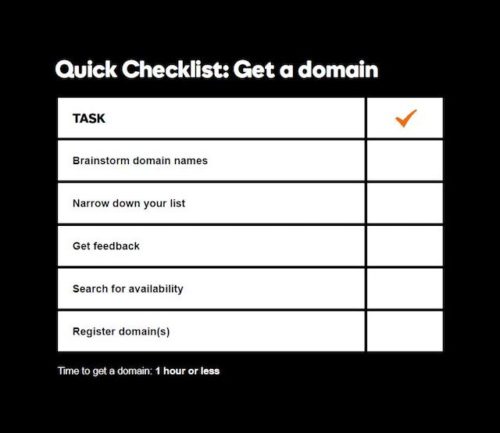
2. Plan your website approach
With that domain name in hand, you’re ready to start thinking about your website. That’s right — thinking about your website. Like most everything else in business and life, a bit of planning goes a long way toward ensuring that your site will do all the things you want it to do for your business.
Do you want your website to inform? To inspire? To generate sales leads? To actually sell products or services?
The nature of most business websites is either informational or sales-driven.
Is it enough for your website to showcase your products and services, or do you want visitors to be able to buy them directly from the site? If so, you’ll want an eCommerce website (more on that later). When you figure out what you want your site to do for your business, you can begin building the type of site that will achieve those objectives.
Planning your website
Excellent! You just worked out the purpose and began to map the direction for your new small business website. You’ll use this information as you move forward with taking your small business online.
Prep to sell online
If you plan to sell products or services on your website, you’ll need an eCommerce website, also known as an online store. This type of website requires a few more specialized parts than a standard website. Here’s what you’ll need to plan for:
A shopping cart. This tool will let you display product images and descriptions. Look for a cart option that includes important features like shipping options and inventory tracking.
Payment processing. While you can use a third-party service like PayPal to collect payments, establishing your own merchant account to accept credit card payments will give your business more credibility. Merchant accounts let you accept payments from major credit, debit and gift cards on your site — so your customers don’t have to leave your online store to pay for their goods.
GoDaddy’s Online Store includes built-in payment processing. That’s a good thing.
SSL. The first thing most savvy customers look for when they make a purchase online is an SSL (Secure Sockets Layer) certificate. SSL certificates are digital certificates that encrypt the information your customers send when they purchase products or complete forms on your website.
Visual indicators of an SSL can include a padlock icon in the browser, https:// before the website address, and a green address bar.
Additional resources
Beef up your website planning with even more info from these resources:
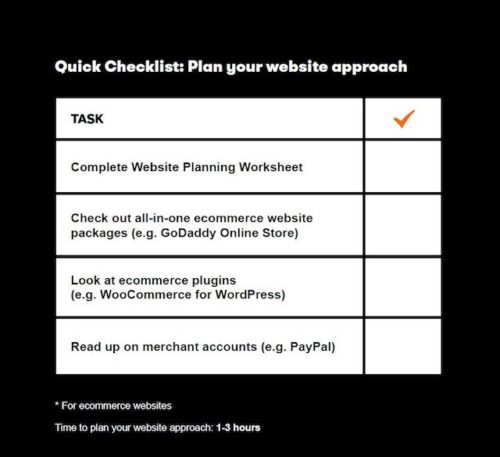
3. Pick your designer
OK, I know that you might not be well-versed in the art of website building — and I don’t expect you to be. The good news is that you’ve got options. Self-starter? You can do it yourself with a template-based site builder or content management systemA content management systemA content management system (CMS... More like WordPress. Too busy for that jazz?
Hire a professional.
But whatever path you take, you’ll want to consider these primary factors: cost, customization, complexity, time, and ongoing maintenance. A good method for making your final decision is to prioritize your most important considerations, then weigh the options against your needs.
Let’s take a closer look at your choices:
Site builder
Site builders like GoDaddy’s Website Builder, Wix and Squarespace are great if you’re a DIY-type who wants an affordable, attractive, basic website in a short amount of time. Simply choose a pre-designed template and then replace the text and images to meet your needs. Swipe-to-style. Easy to create and update. Plus, most popular site builder plans including website hosting.
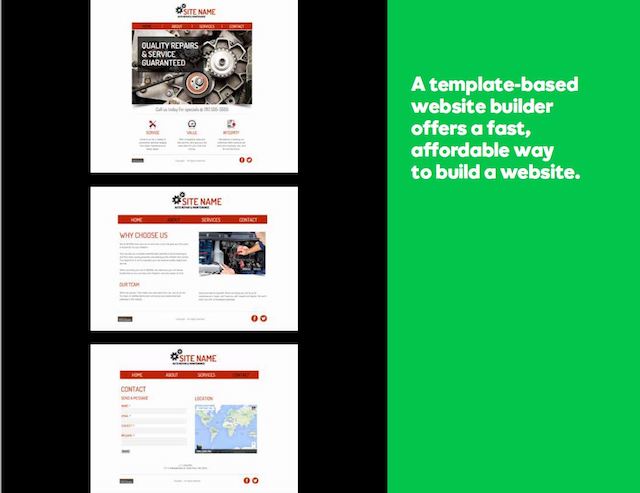
WordPress
Like the idea of building and updating your own website without learning HTML, but want more flexibility than a site builder? If you’ve got a little skill and some extra time, a CMS such as WordPress might be for you. You can choose from myriad free or paid WordPress themes (designs for the overall style of your website). A plethora of plugins also can boost your site’s functionality.
Some WordPress offerings, like GoDaddy Managed WordPress, even bundle hosting, security and support into one plan to make it easier to set up and maintain a WordPress website.
Professional designer
Hiring a professional designer is a great option if you have an idea for your website, but don’t want to build it yourself.
A pro can collaborate with you to turn your vision into a fully functional, customized website that meets your online goals.
Unless you’ve got a designer pal who owes you a big favor, this is the most expensive route to get online. But it can be a great investment when you consider the time and effort it will require for you to build a custom website.
Additional resources
Check out these resources to learn more about your website building options:
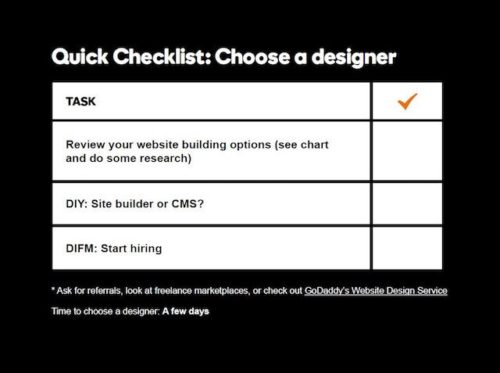
4. Create remarkable content
So, what’s your story? Every business has one. And a compelling story drives an effective small business website. How did you get started? What do you tell customers about your business, or how do you explain to friends how you make a living? What problem can you solve for your customers, as only you can?
Then start writing.
It could be as simple as this:
“I started baking with Mom when I was barely tall enough to reach the kitchen counter. She taught me everything she learned from her mother and grandmother, and encouraged me to pursue my passion in college. I started my bakery right out of culinary school. Today, I might not end up covered in as much flour, but I still love baking as much as I did when I was a kid. I think you’ll taste that passion in my cookies.”
And that, my friends, could be the anchor text for your home page.
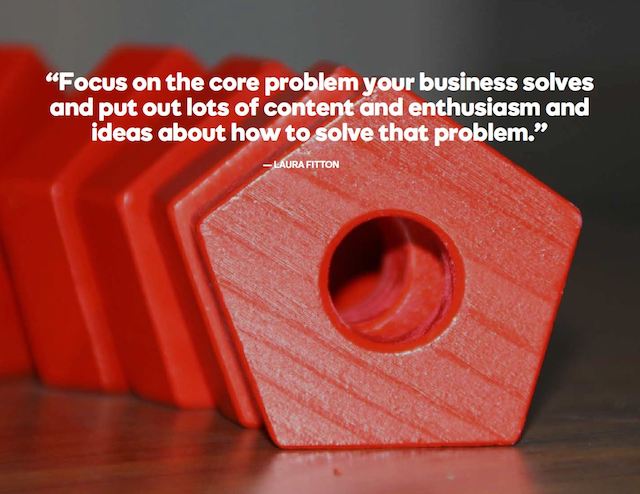
Five core pages
You’re going to tell that story throughout a handful of pages on the your website. I think five core pages — Home, About Us, Products/Services, Testimonials, and Contact Us — makes for a solid small business website, but you really can do it in as few as three pages.
Developing the content for these pages requires telling your story with words that count (text) and images (photos, videos, your logo, etc.), presented in an appealing way (that’s the design factor).
It’s important to make this space — your website — easy for visitors to travel through, or navigate. A click here, a link there, and they’ll get a clear idea of who you are and what you can offer to them.
Get inspired

Not sure how to start telling your business’s unique story on your website? Well, you don’t have to do it alone. Here are a few places you might find inspiration:
- talking to friends
- customer referrals
- existing brochures and other marketing materials
- company newsletters or cards
- other websites
Take a look at what other successful businesses in your industry do on their websites, and note what you like and what you don’t. There’s nothing wrong with getting a little online inspiration, just don’t copy someone else’s content.
Design basics
Even if you hire a pro to build your site for you, you’ll need to make (or at least approve) decisions about the look of the site — its design. Here are a few design fundamentals you’ll want to consider:
Logo. Think about how you want to incorporate your company logo into your website’s design. Maybe you want to echo the colors of your logo on your site, or make the logo “pop” against a contrasting background.
Colors. For brand harmony, it’s important to choose the right color palette for your website. Do you own a creative company? Perhaps vibrant colors like hot pink and tangerine speak to your brand. If you’re in the professional services industry, more subtle hues such as charcoal and blue might be more appropriate. Think about the feelings colors evoke for you and match them with how you want your customers to feel when they visit your website.
Fonts. The way type on your website looks impacts readers subtly, but because text is everywhere on your site, it adds up to a substantial impression. Think about the fonts that might best represent your particular business — from bold, linear styles to more delicate, feminine fonts.
Layouts and more. Consider the amount of “whitespace” (space between elements) in your design. A lot of whitespace can denote clarity or simplicity, while having very little of it can make your site look active or intense. Other elements, like background colors, gradients, and the “texture” of your overall design, can contribute to your online impression.
By putting a little thought into these basic design elements, you’ll make big strides in telling your story, building your brand, and framing your products and services in the best possible light on the web.

Website image tips
How much time would you spend on site where you’re expected you to read everything to understand what’s going on? Not much, I wager. By using a few thoughtfully chosen pictures and/or short videos, you can quickly convey the information and impression you’re going for.
Here are three tips for using images and video on your website:
Show instead of telling. If it would take a thousand words to explain something, showing it is better. This is especially true of product shots and video demonstrations. Use them to create an impact.
Take them yourself. If you need to snap a few shots of a product or make a video, you already have a tool you can use — your smartphone. Just adjust the lighting, be aware of the background you’re using, and snap away. When you’re done, you can edit them using an online editor, or an application like Adobe Photoshop.
Use quality stock images. With stock images, you can save yourself time and get high-quality images at a fraction of the cost of a professional photographer.
Pro tip: If you’re selling products online, it might be worth the investment to have professional photos taken of each product.
Be mobile-ready
Here’s a staggering mobile fact from our friends at Google: 80 percent of smartphone users do shopping research on their phones. They tap and swipe their way through search results, websites and reviews to figure out what they’re going to buy, and from which seller. What then? A full 50 percent of those mobile-savvy searchers visit a store within a day.
If your website isn’t easy to tap and swipe, you’re outta luck.
More than just a site you can see on a phone, a mobile website is optimized for use on a smartphone and other mobile devices. It’s designed for a positive user experience on mobile. Whether you design your own website or hire a designer to do it for you, make sure your small business website is mobile-responsive.
Worksheet: Content creation for websites
Additional resources
Whew! That was a lot of work. Give yourself a pat on the back — you deserve it. Want to take an even deeper dive into content? Here are some resources to help:
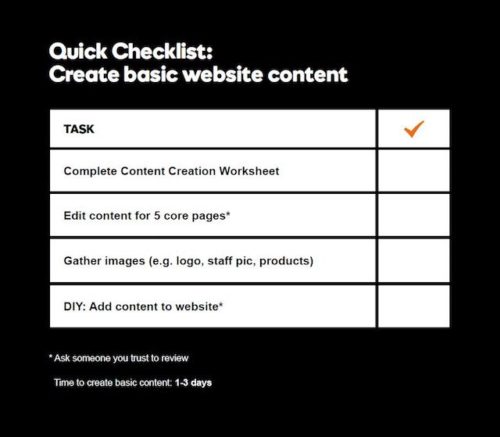
5. Get found
Congratulations! You’ve already accomplished the first rule of thumb for getting your website found when you take your small business online — creating relevant content. The type of content that will resonate with your target customer. Keep at it. (Oh, didn’t I mention that content creation is an ongoing process? Keep it fresh, that’s the mantra.) Now it’s time to take the extra steps needed to boost your business’s visibility online.
Enter search engine optimization, fondly known as SEO.
Search engine optimization (SEO): the process of refining a website to get higher search engine rankings and organic visitors to your site, without paying for search engine placement.
Imagine you’re a chef who’s spent a week perfecting a new recipe. If you don’t get it on the menu, it’s going to collect dust back in the kitchen because most of your customers aren’t going to know about it. It’s the same way with your website — you’ve cooked up all this amazing content, and you want search engines like Google and Bing to serve it up to potential customers in their search results pages. Bake it and they will come? Um, no.
A strong organic search ranking will work wonders at attracting visitors to your website.
Unlike paid listings — advertisements that display in sponsored areas — organic search results are “free” and based on, among other things, the site’s content and how closely it matches the keywords being searched.

How does SEO work (in a nutshell)?
The fun begins after you (or your website guru) does the website backend stuff needed to attract the attention of the almighty Googlebot. Now, search engines know that your site exists. They scan it, index the information, and analyze the website’s content to determine how and where your site should display on the results page. Your site won’t rank well if it isn’t optimized.
While each search engine has its own set of ranking criteria, they all look at these same basic but key elements:
Relevant page content. Again, KING. A good rule of thumb is to include between 300 and 700 words per page, focusing the page content on its target keyword’s subject matter.
Keywords. Do some research to discover what select words and phrases people use to search for your type of business. Sprinkle these keywords throughout the content on your website.
Meta tags. These are HTML tags that contain info to help search engines know what your site’s about. They help describe your website in search engine results (see Tag, you’re it).
Website navigation. This covers all the links on your site and how visitors navigate from page to page. Like visitors, search engines rely on good navigation to get around your site.
In the world of SEO, a broken link is like hitting a brick wall. Make sure all the URLs in your navigation are valid.
Sitemap. A sitemap is essentially a map or directory of all the pages in your website. It guides search engines throughout your site with the names and locations of pages. Learn more about sitemaps.
Link building. Search engines use both internal links and backlinks to rank your site. You create an internal link by linking from a keyword or sentence on one page of your website to another page on your site. Even more important for search ranking are backlinks — links from other websites that point to your site.
Image optimization. This one’s got its own section. Keep reading to learn how to get SEO juice with the images on your website.
Fun with keywords
Once you discover what keywords your target customers use to search for products and services like yours online, it’s time to produce content that targets those terms. For example, if you publish a page targeting the keywords “maple custom cabinets,” include that exact phrase a few times naturally in the body copy.
Be relevant. A relevant keyword helps online users find your site if they search for it using a search engine.
Be specific. Your keywords should represent what you do, your location, the services you offer, your products, and your industry.
Be strategic. Once you’ve chosen your keywords, use them in your website’s content, page titles, metadata and image names. Use each word or word combination, as well as their variations, at least two to three times per page.
Be natural. Overusing, or “stuffing,” your keywords will harm your site’s ranking because search engines read sites like we do. Search engines will penalize you if your content has an excessive number of keywords, so don’t overdo it.
How to optimize images
Your website’s visitors love images, and so do search engines. Include at least one image on each page, and take these steps to optimize each image so you gain referral traffic from Image Search.
- Align the page’s target keyword to the image file name. For example, if the page targets the keywords “beaded turquoise necklace,” the primary image’s file name should be “beaded-turquoise-necklace.jpg.” Always use lowercase and separate each word with a hyphen.
- Use and optimize the Image ALT Text attribution, again using the page’s target keyword. For our example, the Image ALT Text should be “Beaded Turquoise Necklace.” Uppercase, no hyphens.
- Make sure the page text corresponds to the image file name and Image ALT text. Search engines look at the text content around the image to help understand its subject matter. They can safely assume the image actually is a picture of a beaded turquoise necklace if they spy the keywords “beaded turquoise necklace” in the content on the page.
Pro tip: Making your image file size smaller so it loads faster can also help your search rankings.
Tag, you’re it
 Under your website’s hood you’ll find fields to enter various kinds of metadata — including three tags that play a key role in SEO.
Under your website’s hood you’ll find fields to enter various kinds of metadata — including three tags that play a key role in SEO.
Title tag. Displayed in the browser’s title bar and as the title for your listing in search engine results, this tag offers a glimpse of what people can expect from the page. It helps if each page on your site contains a unique title, but keep it concise — less than 65 characters including spaces.
Meta description tag. Displayed below your website’s link in search results, the meta description tag should entice people to visit your site. It’s a must for every page on your site, and should include the keyword for that page. Limit this tag to less than 150 characters.
Header (H1) tag. Each page on your website should include only one H1 tag — generally the most prominent text on the page. This tag doesn’t display in search results, but it tells visitors what they’re reading or viewing (sort of like a chapter title in a book). Keep the header tag short and be sure to include the page’s target keyword.
Do I need a blog?
If you want to increase traffic to your website, boost search engine rankings, and establish yourself as a subject-matter expert — yes. A blogA blog (a truncation of the expression weblog) is a discussi... More also is a great way to interact with your customers and capture feedback about your products and services.
Again, this is all about adding valuable content to the mix.
A blogA blog (a truncation of the expression weblog) is a discussi... More gives you an amazing content marketing vehicle — a means to talk about your company’s values, provide a look behind the scenes, and offer useful solutions without sounding like you’re “selling.”
B2B companies that blogA blog (a truncation of the expression weblog) is a discussi... More generate 67 percent more leads per month than those who don’t.
Your blog’s content makes excellent fodder for your social media sites (more on that soon), and it’s a great way to build relationships with industry influencers and customers by linking to relevant content on their sites. Post consistently for the best results, at least once every two weeks — more often is better.
Reviews, directories and maps
With an estimated 90 percent of online shoppers saying online reviews sway their buying decisions, and 88 percent confessing that they read business reviews on the web to help them determine the quality of local businesses, it’s hard to deny the significance of your business’s presence on sites like Yelp and Trip Advisor.
There’s a good chance you’ve gone to the local restaurant with three stars rather than the eatery with 2.5 stars — so why wouldn’t your potential customers vet businesses the same way?
Online reviews and directory sites (like Google My Business, Foursquare and YP) are a big, fat conduit for new business. If people like what they see, they’ll click the website link in the review or directory listing, and you’ve got a new visitor on your site. Plus, search engines typically pull information from business listing sites and display them under your website address for local search results.
You want your website address (and other information) to be listed on these sites — correctly. You’ve got a few options here:
- You can go to each site individually and update your business’s pertinent information as needed (like when your phone number or menu change).
- You can subscribe to a service (like GoDaddy’s Local Business Listings) that enables you to enter and update that pertinent info in one place, before pushing it out to myriad review and directory sites.
We’re a society on-the-go, and online maps are a go-to source for local business information. They’re a fantastic tool for helping potential customers find your business.
Serious about getting your website found? Find, claim, and verify your business information on key online review sites, directories and maps.
Additional resources
I’m not gonna lie: they’re aren’t too many shortcuts when it comes to getting your business found online. It takes effort. But, with a little knowhow and some extra caffeine, it is totally doable — and totally worth the work involved. Here are some more resources to get you started:
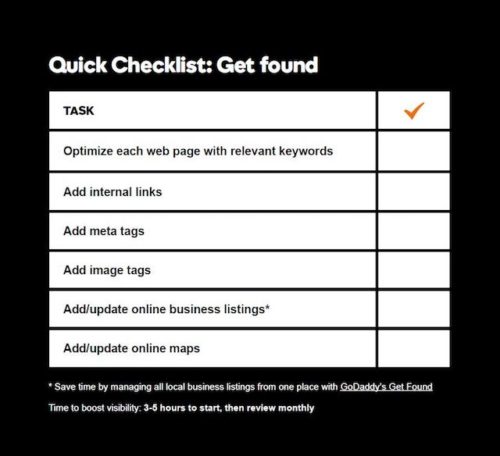
6. Connect with social media
Establishing a business presence on the social networks where your customers and prospects spend their time is sort of like setting up a booth at the world’s largest virtual trade show (although sometimes it feels like a circus). You can bet your competitors are there, vying for the attention of all those potential customers with flashy banners and giveaways. There’s a crowd gathered around the booth playing a funny video and the vendor live-streaming a makeup demo.
Why is social media so important for businesses today, and more importantly, how can you get in on that action?
You can use social media to:
Build relationships. By developing a following on popular social media sites, you can connect with your customers and prospects and share content with large numbers of people. Social makes it easy to target specific customer questions or issues, while making the same information available to all existing and potential customers.
Build your brand. Social media gives you the opportunity to share valuable information about your business and showcase your personality.
Drive traffic to your website. Including a link back to your website in interesting social posts can generate serious traffic.
Establish expertise. Share your knowledge and experience to build credibility as an industry thought leader.
Make sales. Ultimately, these activities — connections, brand building, driving traffic, establishing expertise — all lead to the same place: sales.
Establishing and maintaining a strong social presence for your business definitely requires a commitment of your time, but the benefits make that investment worthwhile. By getting social, you will continue to build credibility, raise brand awareness, and, especially, engage with current and potential customers.
Ready to get started?

Pick your poison
Just like IRL (in real life) you can’t be everywhere — in your studio, at your son’s soccer game, at the grocery store, in the bathtub with your favorite novel — at the same time. Same for social media. You’ve got to figure out where the people who are most interested in your type of products or services are spending their time, and go there.
Different social networks appeal to different demographics.
Some platforms specialize in visual content — perfect for product-centric businesses. Some networks allow you to share long-form content, live-stream video, stay on top of industry trends, and “spy” on your competitors.
Do some research. Where is your target audience hanging out? How about your competitors? What benefits can each network offer your business? Analyze and prioritize.
Take all that data, look at it in the context of the marketing goals you’ve established for your business, and define a social media strategy that works for you.
Best practices for using social media for business
Once you’re all set up on your chosen networks, and listening to get a pulse on your customers and competitors, it’s time to start posting and sharing content. The fun part. To get the most out of social media for your business, it helps to follow a few basic guidelines:
Make friends. Social media is about people connecting with people. So, even if you’re representing a business, be sure to let your human side shine through in your posts. Return favors (such as a sharing and liking posts and pages).
Add value. Provide useful information in your posts, such as links to related articles and videos.
Show some respect. Treat your followers with dignity and respect, and you’re likely to get the same in return.
Practice restraint. One of the quickest ways to lose followers is to overdo it. Posting quality content once or twice a day is enough to engage with your audience.
Get it right. Be sure to check your facts, spelling and grammar.
Encourage open dialogue. Craft posts that encourage followers to respond. Ask questions.
Be responsive. Acknowledge followers’ feedback and engage them in conversation.
Get visual. Post photos, videos, and other visual elements to boost engagement.
Leverage promotions. Come up with special offers for social media followers.
Drive traffic to your website. Include your website address in posts for followers who want to learn more.
Besties: Your website and social profiles

You want your business’s website and social media profiles to be joined at the hip. Texting each other during class. Sharing friends and trading gossip. You get the point. After you set up your social media profiles, post links to them everywhere — on your website, storefront, marketing materials, even your email signature.
Buttons on website. Make it easy for website visitors to become followers by adding social media icons or links to your website.
Links in social posts. Include your website’s URL in your social media posts. Also, add widgets or add-ons to your site so live feeds of your social media posts show up there.
Share, Follow, Like. When people “like” your business’s social page, they become members of your business’s online community. Take every opportunity to “share,” “follow,” and “like” others’ pages so they’ll return the favor!
Time-saving tools
As a small business owner one thing’s for sure — you’re busy. And social media has a well-deserved reputation as a bit of a time-suck. These tools can help you manage your business’s social media presence in less time, with fewer headaches.
Hootsuite. This is a popular tool for scheduling posts in advance and using keywords and hashtags to listen in on conversational streams.
Buffer. It’s super-easy to batch schedule updates and share pages on all your social networks.
Sprout Social. This powerful platform features publishing, engagement and analytics functions that make is much easier to manage and engage on all your social networks.
Likeable Local. This robust tool does the legwork for you, automating the process of providing content on social media and making sure it reaches the right audience for your business.
Feedly. This RSS reader will help you keep track of new posts that go out from your competition.
TweetJukebox. Enter as many tweets as you like, then set a calendar for when you want them to go live.
Additional resources
Feeling a bit overwhelmed? Take a break. Get some coffee. Meditate. Then come back and check out these articles to learn even more before you start getting social:
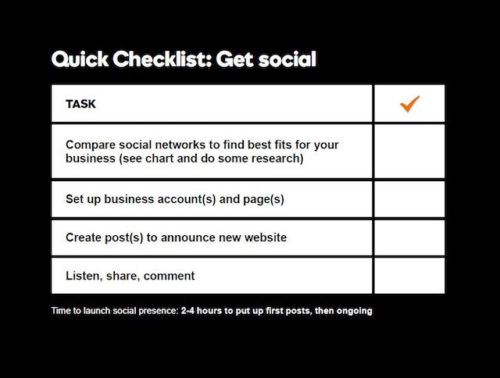
7. Drive traffic to your website
We’ve talked about how your social profiles can drive visitors to your business website (it’s huge), but we’re not quite finished on this topic. Driving traffic to your website is an ongoing process. Like maintaining your hair color. And raising your children.
Like any worthwhile endeavor, attracting visitors to your business’s online home takes time and patience. You might even need to pull out your debit card. Let’s look at a handful of proven strategies …
Create compelling, search-worthy content. Yup, that again. Whether it’s a shareable infographic, entertaining how-to video, or blogA blog (a truncation of the expression weblog) is a discussi... More post about why spending time in your online store is more fun that watching Game of Thrones, make content that people can’t find anywhere else. This is the kind of stuff people will want to link to from their own websites and social profiles (remember backlinks?). Make sure they find that amazing content by optimizing it for search engines.
Send business-class email. Remember that domain you registered? The one connected to your website? You can use it to send branded email to your customers and subscribers. Every time you send an email from that business-class account, you’re marketing your website. Cool, huh?
To really drive traffic back to your website, include strong calls-to-action (CTAs) in your emails. Come up with short, catchy phrases that inspire readers to take a specific action on your website. And that’s just one of many ways you can use email marketing to drum up business on your site — we’re going to dive deeper in the next chapter.
Maximize blogs. Share snippets from your blogA blog (a truncation of the expression weblog) is a discussi... More on your social channels, with links back to the entire post on your website. Drive even more visitors to your site by hosting guest posts from industry influencers and satisfied customers — and ask them to share the link to the post on your website with their social followers. And don’t forget that all that fresh content you add to your blogA blog (a truncation of the expression weblog) is a discussi... More is like candy for
search engines.
Join online communities. Like local meetups, there are online communities for just about every interest and industry you can imagine. Check out forums, blogs and chats related to your market. Leave meaningful comments with links back to relevant content on your website.
Set up shop on a marketplace. Maybe you’re already got an Etsy site or a Fiverr profile — these marketplace sites are handy for promoting your products or services before you set up a website of your own. After you’re up and running, you can use your marketplace pages to drive traffic to your new website. Feature your hand-knitted mittens on your Etsy site, for example, with a link to your online store for the matching scarf. Offer your headline writing services for $50 an hour on Elance, and link to a full menu of your copywriting services on your website. You get the idea.
Run promotions. Everybody loves a deal. Offer online-only promotions, redeemable through your website. Get the word out by sharing the promotion on your blogA blog (a truncation of the expression weblog) is a discussi... More and social media profiles.
Leverage local reviews. Make sure your website address is listed correctly on all those online review sites that 88 percent of your potential customers are visiting for info. If they like what they see — including your feedback — they’re likely to click the link.

Email marketing — It’s your party

With its massive ROI and ability to keep your business connected with subscribers — people who’ve expressed an interest in receiving your emails — you’re missing out if you don’t embrace email marketing. Think of every newsletter and campaign you create as a chance to throw a party for your customers:
Send exclusive invites. Offer subscriber-only savings that recipients can redeem on your site.
Give party favors. Provide useful tips and tricks that link back to blogA blog (a truncation of the expression weblog) is a discussi... More posts on your site.
Play spin the bottle. Include a shout-out to a customer who’s doing something cool with your product or service (with a link to their website).
Crown a party queen. Introduce exciting new products and services with links to your website for more info.
Have cake. Include links to entertaining videos and other stuff that’s just plain fun.
Paid options
Sometimes you’ve gotta give a little to get more. Enter online ads, “sponsored” posts and other paid options designed to put your business info front-and-center and to drive traffic to your website.
A few benefits:
Fast and cheap(er). Online ads cost a fraction of traditional print ads, and you can execute them quickly.
Captive audience. Your ads show up in front of targeted consumers glued to their favorite social networks and other websites.
Easy to measure. You’ll get plenty of handy metrics for measuring the success of your online ad campaigns.
Additional resources
So that’s Driving Traffic 101, in a nutshell. Include your website address and links to your site everywhere — in social posts, email marketing campaigns, business cards, print and online ads, videos, the rear window of your Tesla. You get the point. Here are some resources to learn more about getting visitors to your website:
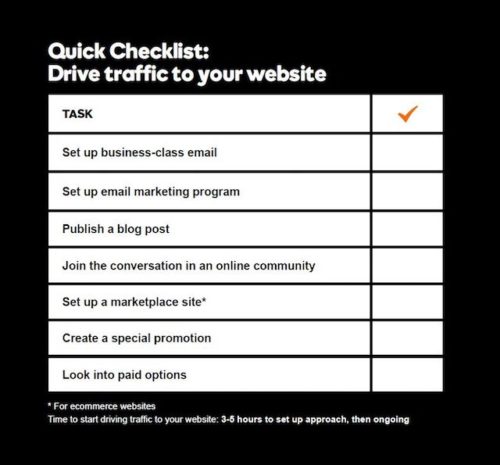
8. Generate leads
Driving traffic to your website is key, but converting your website’s visitors into leads is how you’ll stay in business. That means figuring out who’s visiting your site and contacting them directly so you can work to convert them into customers.
At the end of the day, you’re in sales.
So don’t be timid about asking website visitors to share a little bit about themselves. A little bit. A name and email address. That’s all you need to start converting, and most people are used to giving out that info online. Ask for a phone number if you’ve got a callback strategy in place — but don’t be shocked if some visitors shy away from giving their digits.
Include your business phone number or email address on every page of your website.

Collect email addresses
Email isn’t going anywhere anytime soon. It’s become a part of our daily existence, and the primary way for businesses to connect with customers. But how do you get those valuable email addresses? Sure, you can place some sort of sign-up form on the counter if you have a brick-and-mortar store. You can collect emails at trade shows and other events. That’s great. But your website is a much more powerful tool for soliciting email contact info from people who are interested in what you have to offer.
Here’s how you can collect email addresses and other contact info on your website:
Include a contact form. Visitors will fill out the form on your site because they have a question, need information, or want you to contact them. It’s where they go to connect directly with you.
Add a sign-up form for visitors to receive information about products and services, updates, discounts, etc.
Include an email opt-in box on your checkout page (for eCommerce sites).
Give a special offer for joining the email list.
Pretty straightforward, right? Most popular website builders include a contact form in the template, and WordPress offers some nifty contact form plugins.
Email marketing — worth the investment
Now that you’ve got all those email addresses, what are you going to do with them? How about reaching out to those customers and prospects through a branded, professional-looking email campaign that’s brimming with value for its recipients? Great Idea!
Email marketing offers a targeted approach to connecting with current and potential customers.
After all, they’ve opted in to receive your email correspondence. It can build brand awareness
and loyalty. Even better? The cost. Harvard Business Review called email marketing “the most cost-effective advertising method available today.”
When you invest in a legit email marketing program (like GoDaddy Email Marketing), you get all kinds of goodness:
- It’s easy to add a sign-up widget to your website.
- You’ll store email addresses in a user-friendly database.
- You can export email addresses for use in social media campaigns.
- You can create attractive email campaigns using templates.
- You can track open rates/who clicks on what links.
- You can create contact interest groups.
Businesses that use email to nurture leads generate 50-percent more sales-ready leads and at 33-percent lower cost.
All hail the call-to-action
You want your website visitors to do something — in this case, to give you their contact information. The call-to-action is a means to that end. It’s a concise, convincing and (hopefully) clever offer that requests information from the visitor in exchange for something they might want. You can even link a call-to-action directly to a contact form.
Let’s say you’ve got a real estate website. This call-to-action encourages visitors to give you their contact information: “Looking for the perfect home? Sign up here and we’ll notify you daily about new listings!” In two short sentences — well-placed on your website — you’re giving visitors an easy way to opt-in for a daily email from you. They get something of value, and you get something even more valuable — one step closer to a sale.
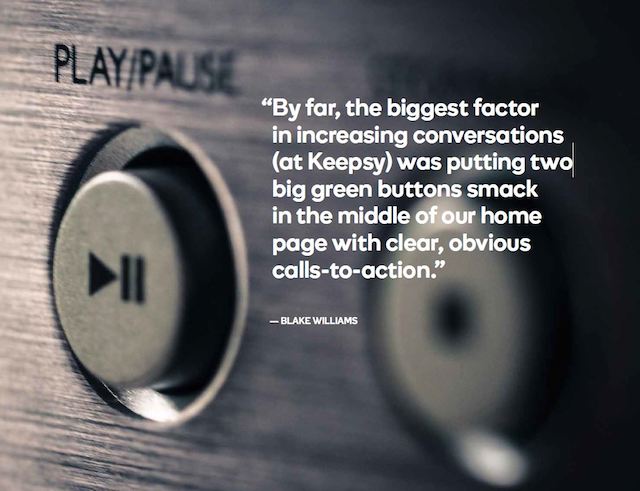
Email marketing best practices
The inbox is a crowded sandbox. You want to send business emails that make it past spam filters, stand out, and entice recipients to open and click. With that in mind:
Only send email marketing campaigns to people who have signed up for or requested them. Look for email marketing programs with opt-in buttons or sign-up forms to help build permission-based contact lists.
Stick to a schedule. Test different days and times to see which combination has the best open rate (the number of list subscribers who opened the email message, a percentage of the total number of emails sent). Be consistent.
Only include requested subject matter. Deliver the kind of information your contacts signed up for, and you’ll build credibility and trust. Send them a newsletter about party planning when they signed up for plumbing tips, and you’ll probably lose a subscriber.
Create interest groups. Placing your contacts in different groups based on their interests or preferences to market more effectively.
Avoid spam and trash folders. To prevent triggering spam filters, avoid using all caps or multiple exclamation marks in the subject line or body of your email.
Give ‘em reading options. Send both HTML and plain text versions of your newsletter so all of your contacts can read your message on their computer or mobile device.
Put a name to your email. Use your personal name or the name of your business as the From or Sender name.
Keep building your contact list. Add calls-to-action and sign-up forms to your website and social media profiles, and collect contact information in person at events or conferences.
Additional resources
Starting to see the potential of your website beyond serving as an online billboard for your business? Turn it into a lean, mean, lead-generating machine! Here’s how you can learn more:
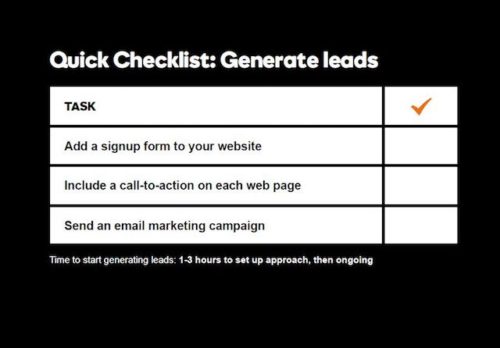
9. Measure, improve, grow
You’ve got a website and social profiles in place, plus the know-how to drive traffic to your site, engage with followers, and generate leads — so you’re in a great position to grow your business. What now?
Stay social. You’ll want to tweak your social media strategy as you gain some experience engaging with followers. What types of content get the most positive response? When are your engagement rates the highest? Is it time to try some paid options? Which social networks seem to be working best for your business?
You don’t want to spread yourself too thin, so make smart use of your time on social. Focus on deeper engagement on the sites that matter most to your audience.
Get mobile. If it isn’t easy for your customers to navigate through your website on their phones and tablets, fix it. According to Kissmetrics, 73 percent of mobile internet users say that they’ve encountered a website that was too slow to load, and 51 percent have tried to navigate through mobile sites that crashed, froze, or spit back error messages. As more and more consumers turn to their mobile devices to browse and buy, it’s important to keep your site off that mobile performance naughty list.
Hone your focus. Channel your time and energy into online efforts that prove most effective for your business — email marketing, a particular social media platform, a call-to-action on your home page, whatever works best for you. After you get some skin in the online game, take a step back and evaluate your progress. Revisit your online marketing goals, and adjust based on your experience.
Keep your website in shape. Updating and maintaining your website’s content and functionality is key to staying current and delivering what your visitors want and need. Plus, continually updating your site with relevant content will work wonders at improving your search engine visibility. Keep it fresh with consistent blogA blog (a truncation of the expression weblog) is a discussi... More posts, up-to-date photos and videos, and design tweaks that reflect evolving trends.
Track your website’s performance
Remember those goals you set for your website? Sure, you’ll know as you get closer to meeting them. But you won’t really know how well your website is working for your business — and how to adjust your online marketing strategy — without help from web analytics. As a small business owner, you need to know how many people are visiting your site, how they found it, and if your online marketing efforts are working. Web analytics products can give you all of those answers, and more.
Web analytics: the measurement, collection, analysis and reporting of internet data for the purposes of understanding and optimizing web usage.
There are a number of products that can analyze your site to tell you what’s working and what’s not. Google Analytics is a good place to start. Here are some of the main metrics you’re going to want to measure:
Visitors. Learn about visitors to your website, such as whether they are new or returning, how they found you, where they are located, and which browsers they are using.
Pages. Gather information on specific pages so you can analyze the effectiveness or popularity of each page on your site.
Referrers. Find out which websites, URLs, search engines and keywords lead visitors to your site.
Ecommerce. Get specifics about revenue-boosting and lead-generating visitor activities, such as purchasing products and signing up for newsletters.
Mobile. Discover how many customers access your site using their mobile devices, and how they use your mobile site.
Social media. Measure the success of your social media profiles with details about others’ engagement with your social content.
Advertising. Learn about the effectiveness of your online marketing efforts, and measure your advertising return on investment (ROI).

Additional resources
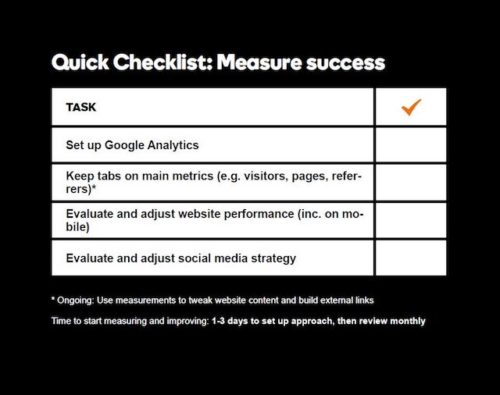
10. Check all the boxes
Congratulations! If you’ve gotten this far, you’ve put in the work it takes to get your small business online — the right way.
Now, are you wondering if you have an effective small business website? Your site should be more than a glorified business card. It should entice visitors to learn more about your products and services, establish that you’re a credible business, and turn your visitors into customers. Even a website with just the bare essentials should help your business grow.
Answer the questions below to see if you’ve covered the basics:
- Do you have clear/concise statements on the home page about who you are and what you do?
- Does your home page have a call-to-action (Ex. Call now, Watch demo)?
- Do you have an about us page that represents your passion for the business?
- Have you included customer quotes, reviews or testimonials?
- Have you clearly defined your products/services, pricing, warranties and refunds?
- Are you collecting email addresses through signup forms?
- Is your primary contact information on every page?
- Have you included “trust logos” (Ex. Better Business Bureau, Awards, Authorized Dealer)?
- Can your visitors share your website through Facebook and Twitter?
- Do you promote a “special offer” for your website visitors?
All done? Great! Now tally up the number of “yes” answers to get your diagnosis.
0 – 4: Sounds like you’re just getting started. Give us a call. We’ll help you out.
5 – 7: You’re on track. Pick one area to focus on this week. Make it happen.
8 -10: You’re a guru. It might be time to take the next step. Email marketing?

Image by: Toa Heftiba on Unsplash



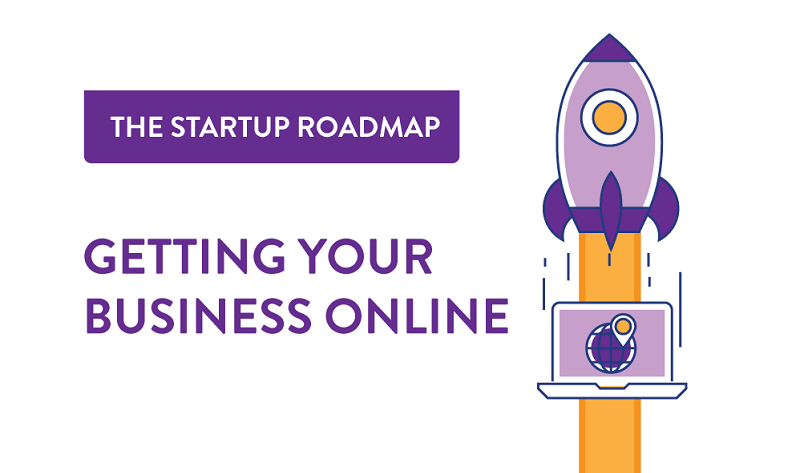
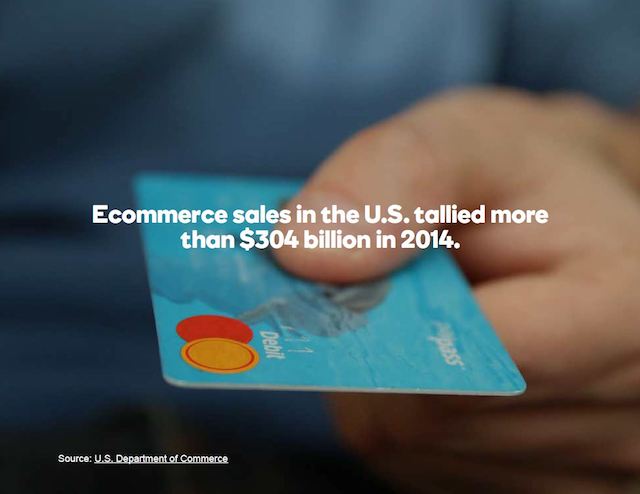
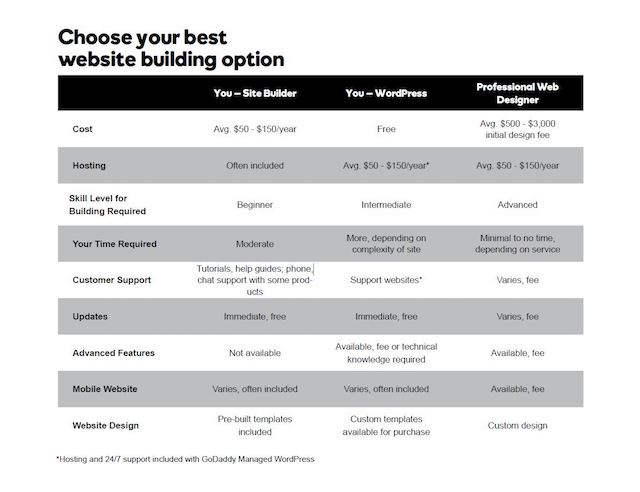

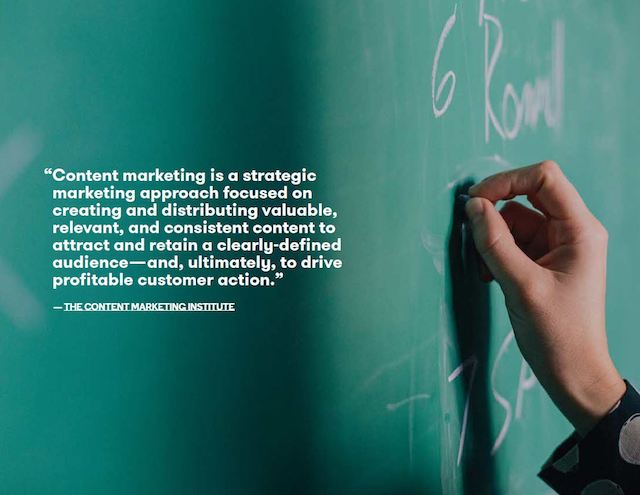
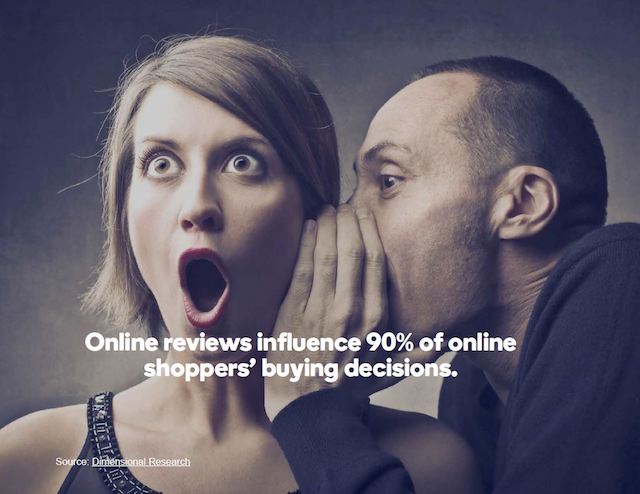




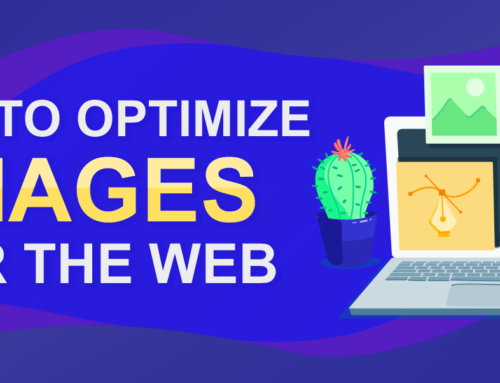
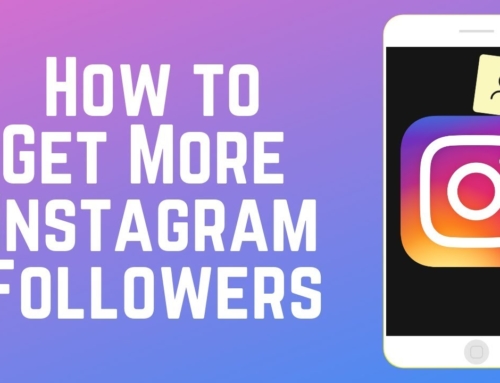

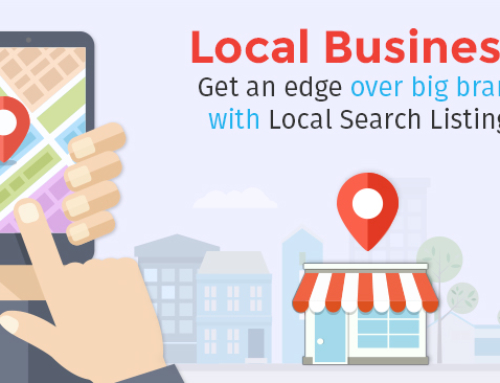

Leave A Comment